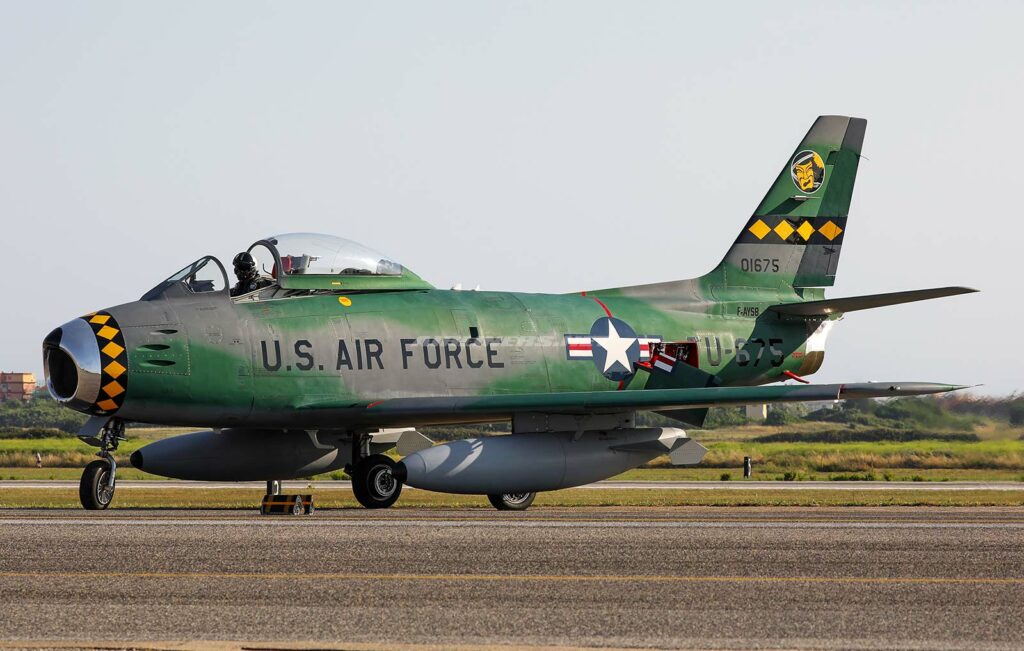The Canadair CL-13 Sabre, a Canadian-built variant of the F-86, is acclaimed for its high-speed performance and agility as a fighter jet.
In brief
The Canadair CL-13 Sabre, a variant of the American F-86 Sabre, was a standout fighter jet of the Cold War era. Produced under license in Canada, it featured several enhancements over its American counterpart, including a more powerful engine and improved avionics. Renowned for its speed, maneuverability, and effectiveness in air-to-air combat, the CL-13 played a significant role in NATO’s air defense during the 1950s and 1960s. It saw extensive service with the Royal Canadian Air Force and other NATO members, proving its worth in various international exercises and deployments. The CL-13’s design facilitated ease of maintenance and operational flexibility, cementing its reputation as one of the most successful jet fighters of its time.
The Canadair CL-13 Sabre represents a critical chapter in the history of jet-powered aviation, highlighting Canada’s significant role in the development of military aircraft during the Cold War.
History of Development
In the context of the escalating Cold War, the need for advanced jet fighters was paramount for NATO countries. The Canadair CL-13 Sabre was developed to meet this need, with Canadair Ltd. in Canada taking on the task of producing an improved variant of the American F-86 Sabre under license.
Launched in the early 1950s, the program aimed to enhance the F-86’s performance to better counter potential Soviet threats. The first flight of the CL-13 occurred on 9 March 1950. The development of the CL-13 was a strategic move to bolster the air defense capabilities of NATO countries, particularly those without their own advanced jet production capabilities.
Design
The design of the Canadair CL-13 Sabre incorporated several advancements over the original F-86. It was equipped with a more powerful Orenda engine, which significantly improved its thrust and overall performance. The aircraft featured a length of 37 feet 6 inches (11.43 meters) and a wingspan of 37 feet 1 inch (11.3 meters).
The CL-13’s airframe and control systems were also refined, resulting in superior high-speed maneuverability and stability. However, these enhancements came with challenges, such as increased fuel consumption and maintenance requirements. Nonetheless, the design changes solidified the CL-13’s reputation as a formidable jet fighter.

Performance
The performance of the Canadair CL-13 Sabre was impressive for its time. The Orenda engine propelled the aircraft to a maximum speed of around 695 mph (1,119 km/h), with a service ceiling exceeding 50,000 feet (15,240 meters). Its range was approximately 1,525 miles (2,455 kilometers).
Compared to its contemporaries, the CL-13 was a superior aircraft in terms of speed and agility. Its performance in NATO exercises and potential confrontations with Soviet aircraft demonstrated its capabilities as a leading-edge fighter jet.
Variants
The CL-13 Sabre saw several variants, each with specific improvements. Notable variants included the Mark 5 and Mark 6, which featured increasingly powerful versions of the Orenda engine and refined avionics. These variants differed in terms of engine performance, armament configurations, and minor structural changes, tailoring them to the specific needs of different air forces.
Military Use and Combat
The Canadair CL-13 Sabre was primarily used by NATO air forces during the Cold War, serving as a critical component of air defense strategies. Its armament typically included six .50 caliber machine guns, with provisions for rockets and bombs, making it versatile in both air-to-air and ground-attack roles.
While it did not see extensive combat, the CL-13 was involved in various NATO operations and exercises, showcasing its capabilities against other contemporary aircraft like the Soviet MiG-15 and MiG-17. The CL-13 was also exported to several countries, enhancing their air forces’ capabilities.
The aircraft was eventually phased out as more advanced jet fighters like the F-104 Starfighter and F-4 Phantom II came into service. However, its legacy continued in the form of advanced training and secondary roles in some air forces.
The Canadair CL-13 Sabre stands as a testament to Canada’s aerospace engineering prowess and the collaborative efforts within NATO during the Cold War. Its development, operational history, and impact on air combat strategies underscore its significance as a high-performance fighter jet in the mid-20th century. The CL-13’s legacy endures, reflecting the evolution of military aviation and the enduring importance of air superiority.
Back to the Fighter Jet section.